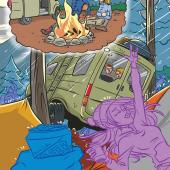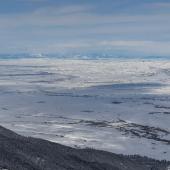New Spark for an Old Flame
The valleys we inhabit are prone to wintertime inversions—just take a quick trip through Missoula in January for a perfect example. Without a moving weather system to clear out the air, particulate matter can easily accumulate to unhealthy levels. The Environment Protection Agency (EPA) is especially concerned with fine particles known as “PM 2.5”: particulate matter 2.5 microns in size that can become lodged in the lungs, causing long-term health threats. In an effort to decrease such dangerous particles in the air we breathe, the EPA set limits for wood stove emissions in 1988. Now, under pressure from state air agencies throughout the country, the EPA is about to lower emission levels even further. Pellet stoves, masonry heaters, and outdoor boilers (previously exempted from regulations) will now be included in the EPA review. Details of the new wood-burning regulations are expected out this spring for a 90-day comment period.
Using a wood-burning stove to help heat your home is often an essential ingredient of cold-weather living. Diminished heating bills and a lowered dependency on fossil fuels are major payoffs, but there are many more benefits to using an EPA-certified wood stove. Burning wood wisely—using dry, split wood in conjunction with high-efficiency appliances is considered to be “carbon neutral.” During its lifecycle, wood traps carbon dioxide—a major greenhouse gas. Whether burned as fuel or decomposing naturally, that once-trapped carbon dioxide will find its way into the atmosphere; and while the timeframe is certainly different, wood burning does not contribute any net addition of greenhouse gases.
Investing in an EPA-certified wood stove that meets or exceeds current EPA emission limits pays dividends beyond healthier air. Today’s stoves have improved combustion technology and higher efficiencies, which means you burn 20 to 30% less wood than with the old clunker. Masonry heaters, though more costly, are one of the cleanest burning and most efficient ways to utilize cordwood, and have been in existence for centuries. Pellet-burning stoves have long been recognized for their low emissions. With a pellet burner, you can sell off the chainsaw and get some weekends back!
The Alliance for Green Heat—an independent nonprofit organization that promotes the use of wood as a green heating alternative—has announced the selection of 14 finalists in the Next Generation Woodstove Design Challenge. The burn-in will take place in November 2013 on the Mall in Washington D.C. The designs consist of highly efficient stoves with microprocessors, state-of-the-art hybrid stoves, and even several ultra-efficient masonry heaters designs from the 17th century—all of which offer high-combustion efficiency and heat storage.
So whether looking backwards in history for the ultimate flame, embracing current technology, or waiting for the right smartphone app to light your fire, consumers have many choices when it comes to cleaning up their acts.
Ron Pihl is the President of WarmStone Fireplaces and Designs in Livingston, and a board member of the Northwest Hearth Products and Barbeque Association. Ron has been building masonry heaters in Montana since 1982.
Photo by Muffet













